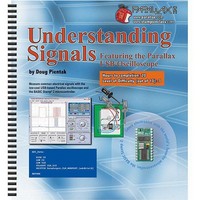70009 Parallax Inc, 70009 Datasheet - Page 107

70009
Manufacturer Part Number
70009
Description
BOOK UNDERSTANDING SIGNALS
Manufacturer
Parallax Inc
Type
Signal Analysisr
Datasheet
1.70009.pdf
(137 pages)
Specifications of 70009
Style
Book
Title
Understanding Signals
Contents
Guide to Generate, View and Measure Wave Forms
Product
Microcontroller Accessories
Lead Free Status / RoHS Status
Not applicable / Not applicable
Other names
70009PAR
Available stocks
Company
Part Number
Manufacturer
Quantity
Price
Company:
Part Number:
700090B
Manufacturer:
COPAL
Quantity:
5 510
Company:
Part Number:
70009CB
Manufacturer:
VISHAY
Quantity:
5 510
Part Number:
70009GB
Manufacturer:
TI/PHILIPS
Quantity:
20 000
Chapter 8: Operational Amplifiers
many types of amplifiers, each with different characteristics. This chapter will introduce
you to simple signal conditioning with an operational amplifier, commonly called an op-
amp (Figure 8-1). Op-amps have many, many potential functions in a wide variety of
applications, but our introduction will be limited to a few common examples.
OP-AMPS AND THEIR USES AND LIMITATIONS
The op-amp is a very easy to use voltage amplifier. It accepts a voltage as an input and
produces a mathematically related voltage on its output. Resistors can be used to
configure the mathematical function that dictates the related output. By using a formula
to select the input resistor (Ri) and the feedback resistor (Rf), you can set the gain of the
op-amp. The gain is a numeric multiplier that refers to the relative difference between
the voltage of the input signal and the voltage of the output signal. Therefore, once you
know the gain of a given op-amp circuit, you can multiply the input voltage by the gain to
get the output voltage. For example, an op-amp with a gain of 2 will have an output
voltage twice the input voltage.
There are limits to the op-amp that need to be considered before proceeding. The main
limiting factors are:
Supply Voltage
Supply voltage and output range are related. An op-amp cannot create output signals any
larger than the voltage applied at the Vcc and Vee pins. This output voltage (or range) is
called the dynamic range of the op-amp. Some op-amps can have a dynamic range as
large as the span of the voltage supplied; they are called rail-to-rail op-amps. For
Amplifiers are used in everything from car stereos to medical equipment. There are
•
•
Supply voltage and output range
Slew rate
Non-inverting
Inverting
Input
Input
Vcc
Vee
Output
Figure 8-1:
Op-amp schematic
symbol



















